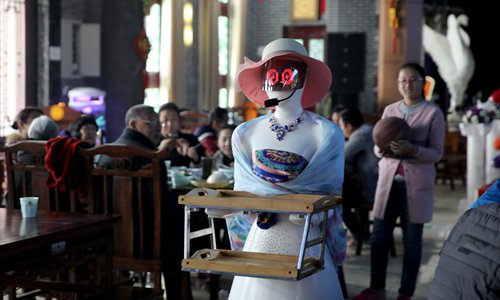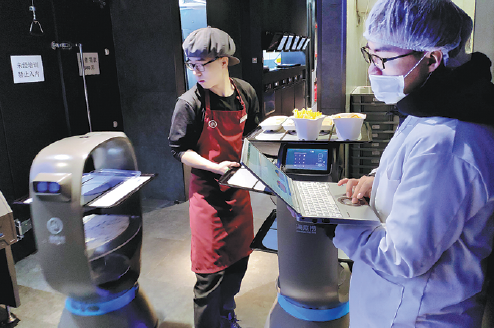
From the People's Daily app.
And this is Story in the Story.
China is the world's largest market for industrial robots. The International Federation of Robotics estimated the country is expected to have at least 800,000 robots by 2020.
A recent report said AI will impact 70 percent of the country’s 400 most common occupations.
According to China’s National Bureau of Statistics, the country had 776 million employees heading into 2018, with just over half of that figure working in urban areas.
By 2030, automation will make up one-fifth of China's manufacturing sector. It is also expected that nearly 100 million workers will need to find different occupations.
Last year, China's catering industry posted a record high $628 billion in revenue.
The country’s surging catering market has shown that demand for diversified cuisine is nationwide thus prompting the emergence of “intelligent catering” so businesses can keep up with the pace.
Today’s Story in the Story looks at how China’s food and beverage industry is turning to AI technology to keep up with the country’s soaring culinary demands.

A robot server is seen in a restaurant in Sanmenxia, Henan Province. (Photo: Global Times)
A famous hotpot chain has become even more popular since it opened an intelligent restaurant in downtown Beijing, where patrons eagerly wait for two hours just to get a table.
The restaurant’s kitchen utilizes 18 automatic "machine arms" in a dish sorting room that is kept at 4 degrees Centigrade. The robotic arms can process close to 8,000 dishes a day. Windows allow guests throughout the 93-table dining area to watch the robotic action.
Within 10 minutes of placing an order with a smart tablet, six plate-carrying robots bring meat and vegetables to each table that is designated with tag location technology.
The robots can run an entire day after being charged overnight.
Zhang Jinshan, the restaurant’s technical trainer, explained that the restaurant is supported by two intelligent systems.
"One accurately copes with customers' canceled, added and urgent orders, analyzes restaurant data, monitors the operating condition of the equipment, provides software maintenance and checks food inventory and expiration dates,” Zhang said.
The other is an energy management system, which analyzes energy consumption including water, electricity, and gas, Zhang added.
This isn’t the only intelligent hotpot restaurant in China.
E-commerce giant JD.com recently opened its smart Xcafe restaurant in Tianjin.
The 400-square-meter dining hall can hold 100 people. Ordering, assembling, cooking, dispatching, dining and checking out are all facilitated by robots and an artificial intelligence system.
In the kitchen, one person operates five robots, and the restaurant offers 40 different food courses.
JD is transforming and upgrading traditional industries using AI, robots and big data, said its Vice President, Xiao Jun.

Workers operate a waiter robot to bring the food to dining tables. (Photo: Xinhua)
The intelligent restaurant is the company’s attempt to combine catering with advanced technology. Xiao said he expects that "unmanned technology" will have broader applications.
China’s catering market has revealed that diversified flavor demands exist across the country.
Thus, intelligent catering has to improve the capability of automatic machines to prepare a wide range of dishes, said Tang Siyu, director of Xcafe.
Intelligent restaurants are expected to solve the problem of rising human costs in the catering industry, and JD hopes to make the technology applicable in practice, Tang said.
Tang admitted that intelligent restaurants are still in their early stages. He predicted the intelligent catering industry will attract more merchants in the following three to five years.
But not everyone is so keen on the idea, "Chinese cuisine is extensive and profound," said Zhang Yi, chief executive officer of iiMedia Research.
"Take noodles as an example; we have various kinds of noodles from north to south and from west to east," he said. "I believe handmade sliced noodles taste much better than those made from machine hands."
Feng Jun, a member of the fast food professional committee, China Cuisine Association, acknowledged that jobs in the catering industry could be divided into three categories: physical labor, skilled labor and emotional expression.
"The fast-food industry can make full automation happen, while high-end restaurants require more considerate service by people," Feng said.
(Produced by Nancy Yan Xu, Lance Crayon, Brian Lowe, and Chelle Wenqian Zeng. Music by: bensound.com Text from Global Times and China Daily.)


